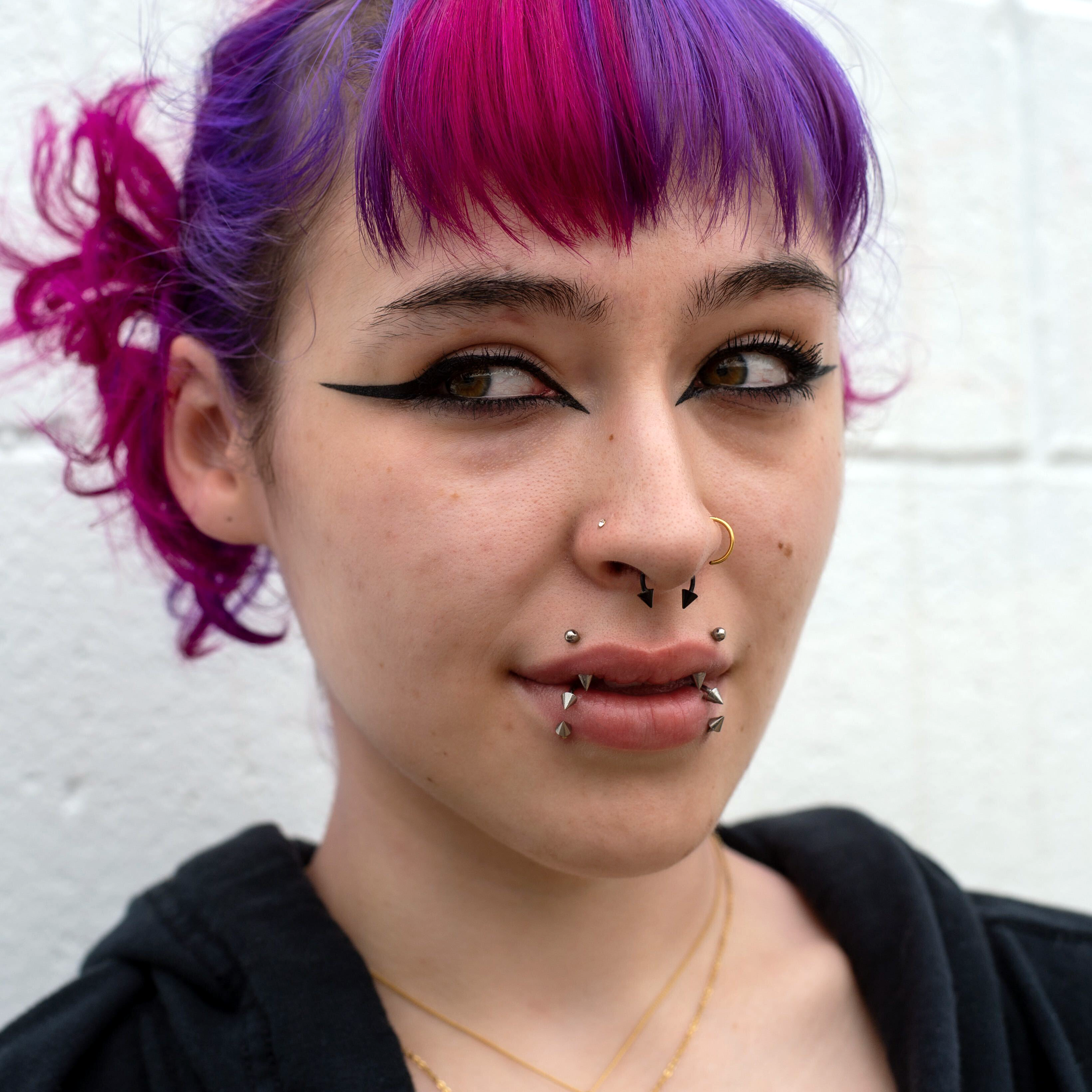Oral Piercing Aftercare
The suggestions that follow are intended as guidelines to help you care for your new piercing. They are based on our decades of experience as professional piercers, the experience of others who are respected in the industry, and the advice of medical professionals familiar with piercing care. Keep in mind that everyone is unique in body and lifestyle, and many factors contribute to how a piercing heals.
We offer free consultations at any time during the healing process, so we hope you will check in during this time.
Estimated Heal Times
The following is usually the minimum amount of time needed to heal before it is safe to change your jewelry. Because many factors influence how quickly a piercing will heal, some people will heal faster while others will take longer. Please be aware that these are only initial healing times. Most piercings will take years before they can be left out for any extended length of time without shrinking or closing. Multiple piercings healing simultaneously may result in longer healing times.
Two Important Things to Remember:
DO NOT TOUCH YOUR PIERCING. The only time you will touch your piercing is when you are cleaning it, and you will first wash your hands.
DO NOT REMOVE YOUR JEWELRY. New piercings can shrink the moment jewelry is removed, making it painful or impossible to get it back in.
What is normal during the healing process?
Bleeding, bruising, and/or swelling are fairly common with a new piercing.
Some tenderness or discomfort in the area of a new piercing can be expected for several days or longer. Discoloration (redness) and itching during healing process are also fairly common.
Secretion of a whitish-yellow fluid (not pus) is part of the healing process and is to be expected. It is liquid when it leaves the body but dries into “crusties.”
Piercings will go through “ups and downs” while healing. They may seem healed for a while, and then regress. The key is to continue your cleaning routine throughout initial healing time.
Piercings (including healed piercings) that are not cleaned daily may smell unpleasant. This does not necessarily indicate a problem.
Jewelry should not be expected to rotate or move freely in most piercings, even after healing.
Most piercings will shrink or close very quickly if the jewelry is removed, so if you like your piercing it is vital to leave your jewelry in at all times!
AFTERCARE
1
Wash your hands thoroughly.
2
Either spray the saline directly on the piercing to liberally flush the piercing, or soak a non-woven gauze in saline and apply that to the piercing.
You may need to use a q-tip or non-woven gauze to clean away any debris or “crusties” that may have collected on the jewelry around the piercing.
It is not necessary to rinse this product away, however if you do rinse make sure it’s with clean, running water.
If your jewelry is threaded (barbells, etc.) check it to make sure it’s still tight! Remember “righty tighty, lefty loosey.”
Use a Diluted, Alcohol-Free Mouthwash - Morning and Evening
Oral hygiene must be maintained while any piercing inside the mouth is healing, however using a mouthwash that is too strong can damage cells and slow the healing process. Be sure to choose an alcohol-free mouthwash such as Biotene, Crest Pro-Health, or Colgate Advanced Care, and dilute it 50/50 with distilled or bottled water. Do not touch your piercing without first washing your hands; and leave your jewelry in at all times!
Wash your hands thoroughly.
Swish gently with an alcohol-free mouthwash, diluted 50/50 with distilled or bottled water, for 30-60 seconds.
If you wish, you may rinse your mouth with clean, bottled water.
If your jewelry is threaded (barbells, etc.) check it to make sure it’s still tight!
Remember “righty tighty, lefty loosey.”
RINSE WITH COOL, BOTTLED WATER AFTER MEALS, SNACKS, OR SMOKING
Things to Avoid While Healing a Piercing
Avoid touching your piercing, except when you are cleaning it.
Avoid oral contact or contact with other people’s body fluids.
Avoid using any aftercare products or ointments that were not suggested by your piercer.
Avoid getting lotions and/or makeup in or around your piercing.
Avoid pools, hot tubs, lakes, rivers, etc. Using a waterproof, breathable bandage (such as Tegaderm) is a viable option for some piercings.
Sucking thick beverages (such as milkshakes) through straws.
Hot, spicy foods and excessive consumption of alcohol, aspirin, and caffeine. • Smoking. If you do smoke, rinse with cold bottled water afterwords.
Chewing on gum, tobacco, fingernails, and other things that are not food.
Playing with your jewelry; it can cause irreversible damage to teeth and gums.
ADDITIONAL SUGGESTIONS FOR HEALING AN ORAL PIERCING
Gently suck on ice for the first few days to reduce swelling.
The use of non-steroidal anti-inflammatory products such as Ibuprofen (Motrin, Advil etc.) can reduce swelling.
This is a good time to replace your toothbrush with a new one!
Be sure to brush your tongue and jewelry (gently at first) to ward away plaque build-up.
Come back in for JEWELRY DOWNSIZING at the end of your initial healing time. Oral piercings have a tendency to swell and need extra room for cleaning during the initial healing time. For your safety and comfort, we provide you with jewelry that has some extra length on the post. Once swelling subsides, it is advisable to replace the initial jewelry with a shorter post. Failure to do this will result in greatly increased chances of tooth damage (chipping, cracking, etc.), gum recession, and bone loss.
Do not clean your piercing more often than is suggested, as over-cleaning can slow the healing process and cause more harm than good.
Taking a multivitamin containing zinc and vitamin C can boost your body’s healing abilities. • Keep in mind that stress, poor diet, drug abuse, or illness can cause extended healing times or other difficulties.
If you feel your piercing is infected, contact us or a physician right away! Although we are not doctors, we are happy to give suggestions based on our experience. Keep in mind that some redness, tenderness, swelling, and discharge is normal for a healing piercing, but we advise clients to consult a health care professional for unexpected redness, tenderness, or swelling at the site, any rash, unexpected drainage from the piercing, or a fever within 24 hours of the body art procedure.
QUESTIONS? CONCERNS?
Give us a call at 505-255-4567, or stop by and see us. Consultations are always free - we love to see how your piercings are doing!











